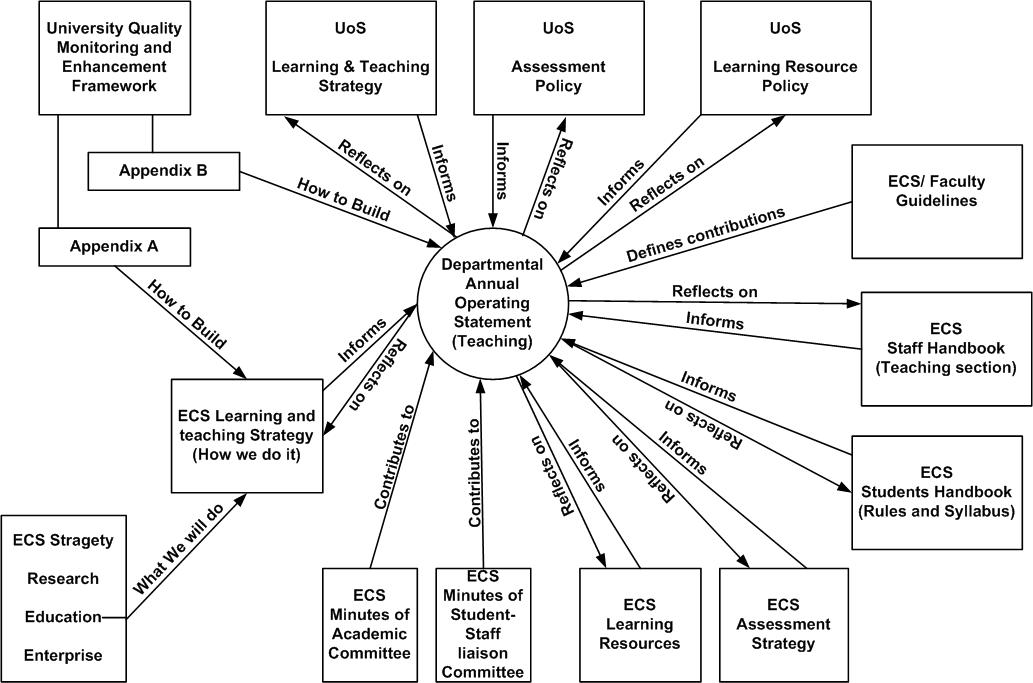
Case Studies: ECS Annual Operating Statement
1.
Introduction.First we describe a general scenario and then present a couple of specific examples.
Consider the following scenario: a manager writing a policy statement is required to draw together information held in a number of business documents: corporate vision statements, corporate strategy documents, departmental policy documents, management summaries, financial reports, public relations statements etc. While reading the content of those documents, the manager will also want to know their purpose (e.g. the intended audience) and authorship (e.g. the authors’ role and position of influence) in order to be confident about any inferences made from the documents.
Hypermedia design methods help :
While document management systems help
However, managers do not often have sufficient time for unbounded browsing and searching to evaluate the appropriateness of supplementary documentation. What they could reasonably ask of a semantically-enriched support environment is to identify relevant material from appropriate documents, based on the context in which new material is being written.
The above general scenario is not well supported by ad hoc searching, but neither is it easily implemented with current web and hypermedia design models. Such models address the relations between information assets to provide site design and navigation features at the level of the document, unit or Web page, but fail to identify the connections between related information fragments for example an institution’s three critical success factors and three section headings in the middle of its corporate strategy document. Managers need a system that will help expose the relationships within the content of the individual documents, e.g. that bullet point 1 of a Company policy document is expanded in paragraph two of the Departmental policy document.
1.1 ECS Annual operating Statement Scenario.
Each year the School of Electronics and Computer Science write an annual operating statement.

Notes to diagram.
Document use in creating the Annual Operating Statement.
The diagram above is very much the perspective of the learning and teaching coordinator (L&TC) for ECS and the person responsible for editing the final document.
Examining the AOS showed that only a small proportion of the documents were used by many of the section authors. Each of the section authors where given the ECS guidelines and Appendix B of the University’s Quality Monitoring and Enhancement Framework document.
The majority of the section’s contained summaries of decisions agreed and papers presented at the Academic Committee. Hence these can be found in the minutes of the Academic Committee and to a lesser extend information is used from Staff-Student Liaison Committee. For example the section relating to the changes in the Computer Engineering Programme:
There are a few explicit references to the Staff Handbook and the Student handbook.
6.9 Plagiarism Matters Departmental commitment
The Department clearly specifies its policy on plagiarism in the Departmental
Handbook, Section 3.2.13 Disciplinary Matters: Plagiarism Procedures (page 25). The policy is firmly based on the University Calendar (Section IV General Regulation 10) and has been carefully followed. Plagiarism checking software, such as JPlag, is regularly used to test programming submissions for plagiarism.
Student awareness
The student Courses Handbook contains a clear statement on Plagiarism in Part A, Section 3.1; a copy of this is given to every student on registration. A note reminding students of this appears on coursework instructions and students are reminded of this issue by staff in lectures. Students should be well aware of Departmental policy on Plagiarism.
Table 1 Excerpt from AOS page 33 (Italics mine)
The remaining documents are not explicitly used.
Conclusions for the AOS scenario
The interesting point raised from investigation into the AOS scenario was that many of the documents were not explicitly used/referenced, theses are indicated in the diagram as being used to ‘inform and reflect on’. Hence this appears to be a limitation of trying to use the WICK tools in this type of document. Where a document contributes to the AOS it is easy to see how this knowledge is used in writing the AOS. However, where documents that are used to inform and reflect on, are used still requires a considerable amount of interpretation of these by the editor and authors of each section.
Compare this to the AKT Mid term review. The mid term review documents for the Advanced Knowledge Technologies (AKT) Interdisciplinary Research Collaboration (IRC) demonstrates more appropriately how knowledge can be reused. In part this is because the documents for the midterm review documents have: